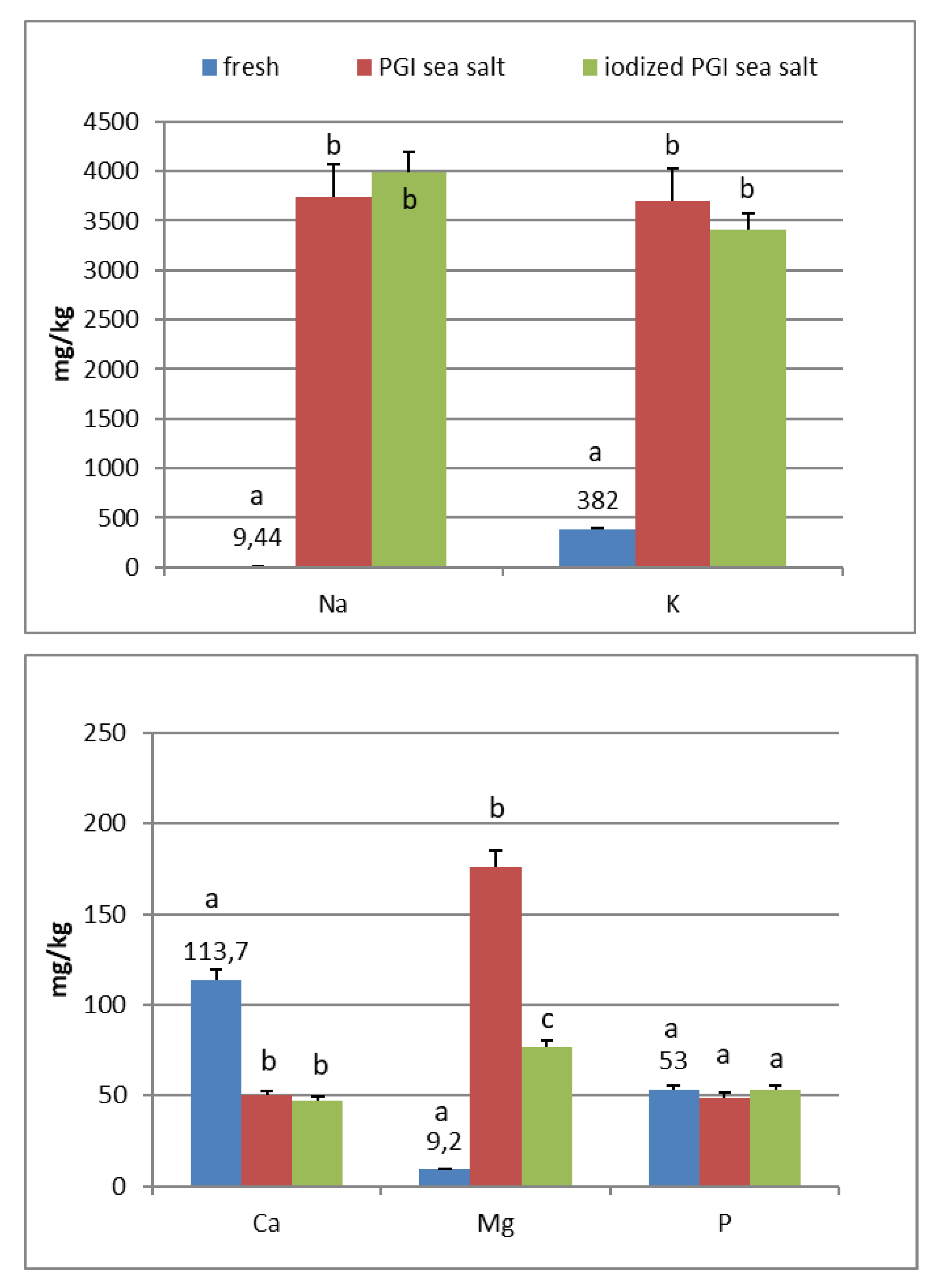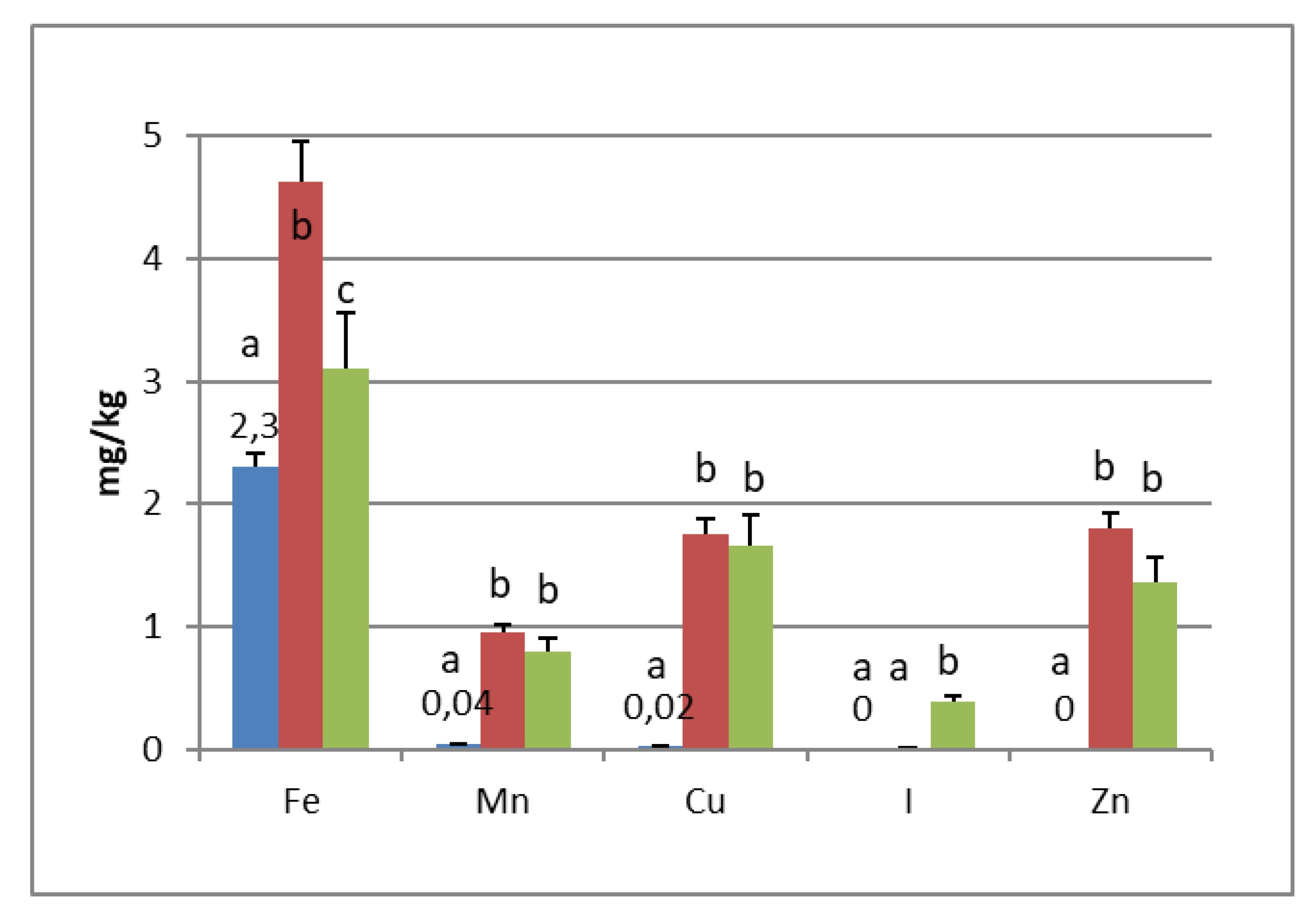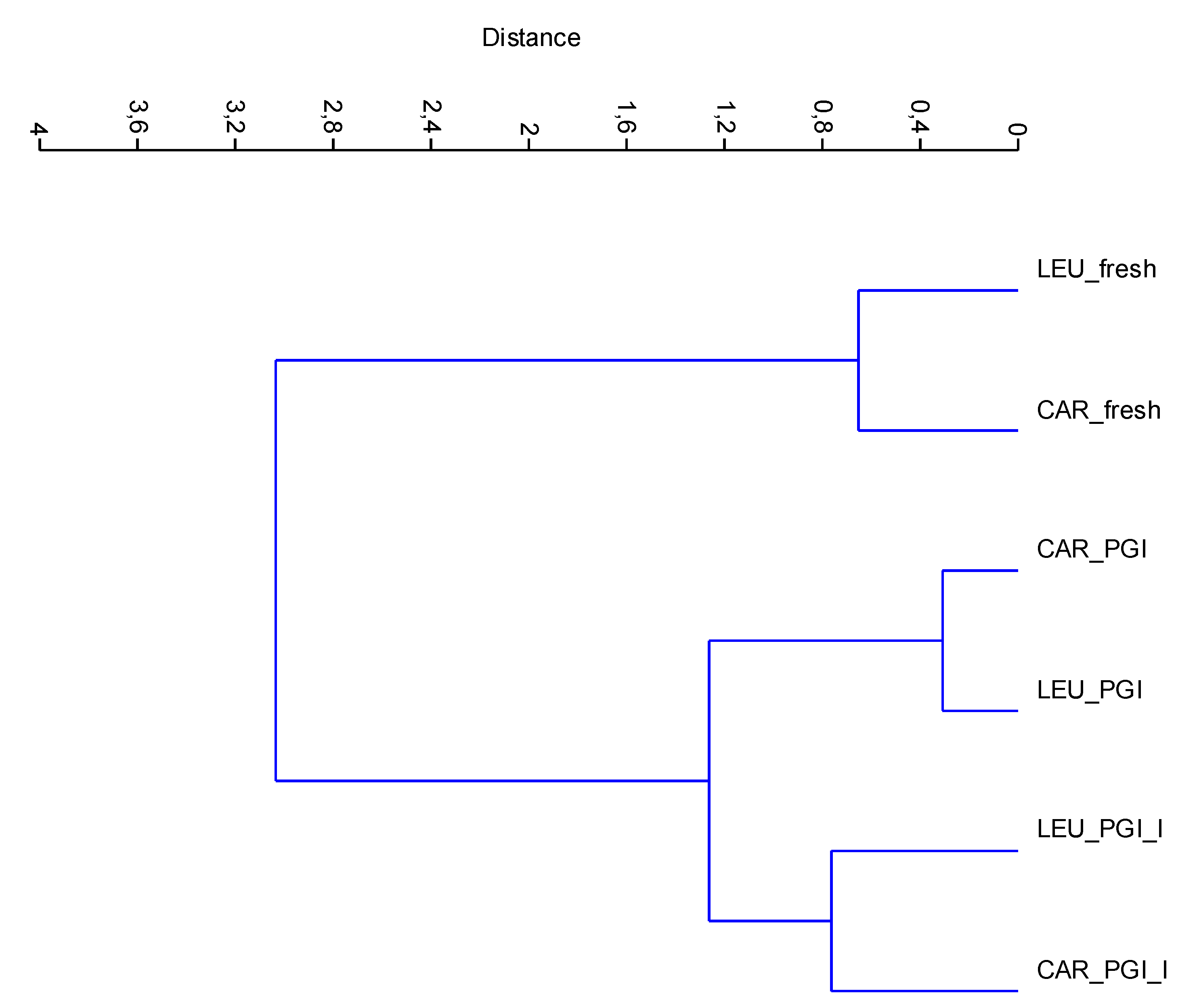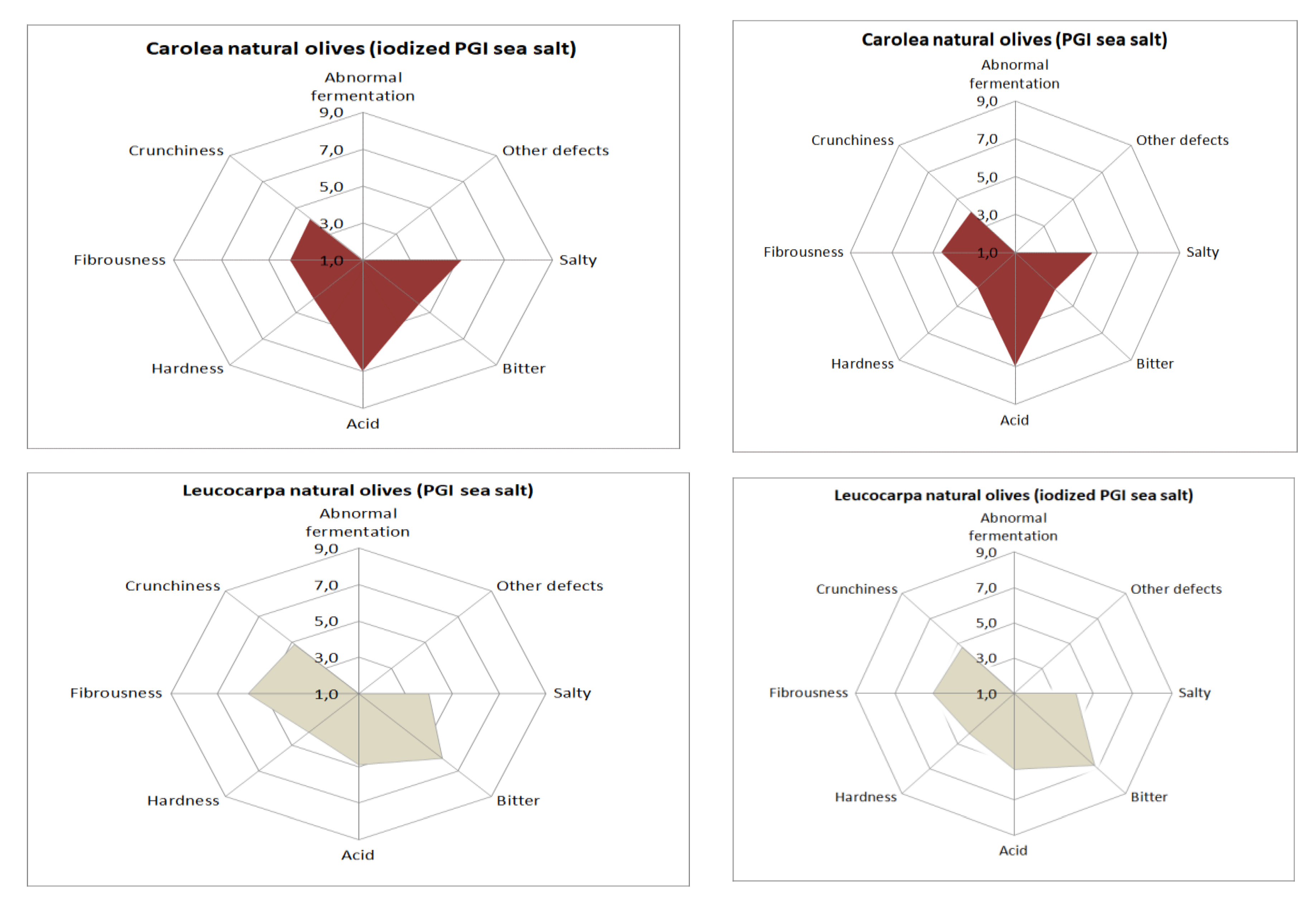Table Olives Fermented in Iodized Sea Salt Brines: Nutraceutical/Sensory Properties and Microbial Biodiversity
Abstract
:1. Introduction
2. Material and Methods
2.1. Samples and Treatments
2.2. Mineral Composition
2.3. Microbiological Monitoring
2.4. Sensory Evaluation of Table Olives
2.5. Determination of Color
2.6. Statistical Analyses
3. Results and Discussion
4. Conclusions
Author Contributions
Funding
Conflicts of Interest
References
- Lanza, B. Nutritional and Sensory Quality of Table Olives. In Olive Germplasm—The Olive Cultivation, Table Olive and Olive Oil Industry in Italy; Muzzalupo, I., Ed.; IntechOpen: Rijeka, Croatia, 2012; pp. 343–372. [Google Scholar] [CrossRef] [Green Version]
- CODEX STAN 66-1981 (rev. 2013). Standard for Table Olives. Available online: http://www.fao.org/fao-who-codexalimentarius/sh-proxy/en/?lnk=1&url=https%253A%252F%252Fworkspace.fao.org%252Fsites%252Fcodex%252FStandards%252FCXS%2B66-1981%252FCXS_066e.pdf (accessed on 25 January 2020).
- Blekas, G.; Vassilakis, C.; Harizanis, C.; Tsimidou, M.; Boskou, D.G. Biophenols in table olives. J. Agric. Food Chem. 2002, 50, 3688–3692. [Google Scholar] [CrossRef] [PubMed]
- Haldimann, M.; Alt, A.; Blanc, A.; Blondeau, K. Iodine content of food groups. J. Food Compos. Anal. 2005, 18, 461–471. [Google Scholar] [CrossRef]
- SINU. Intake Levels of Reference of Nutrients and Energy; IV revision; Italian Society of Human Nutrition: Milan, Italy, 2014. [Google Scholar]
- EFSA. Dietary reference values for nutrients. Summary report. Eur. Food Saf. Auth. 2017, 14, e15121E. [Google Scholar] [CrossRef] [Green Version]
- Regulation (EU) No 1169/2011 of the European parliament and of the council of 25 October 2011 on the provision of food information to consumers, amending Regulations (EC) No 1924/2006 and (EC) No 1925/2006 of the European Parliament and of the Council, and repealing Commission Directive 87/250/EEC, Council Directive 90/496/EEC, Commission Directive 1999/10/EC, Directive 2000/13/EC of the European Parliament and of the Council, Commission Directives 2002/67/EC and 2008/5/EC and Commission Regulation (EC) No 608/2004. Off. J. Eur. Union 2011, L 304, 18–63.
- FAO/WHO. Chapter 12. Iodine. In Expert Consultation on Human Vitamin and Mineral Requirements; FAO: Rome, Italy, 2001. [Google Scholar]
- Krajčovičová-Kudláčková, M.; Bučková, K.; Klimeš, I.; Šeboková, E. Iodine Deficiency in Vegetarians and Vegans. Ann. Nutr. Metab. 2003, 47, 183–185. [Google Scholar] [CrossRef]
- Arroyo-Lopez, F.N.; Querol, A.; Bautista-Gallego, J.; Garrido-Fernandez, A. Role of yeasts in table olive production. Int. J. Food Microbiol. 2008, 128, 42–49. [Google Scholar] [CrossRef]
- Bautista-Gallego, J.; Rodriguez-Gomez, F.; Barrio, E.; Querol, A.; Garrido-Fernandez, A.; Arroyo-Lopez, F.N. Exploring the yeast biodiversity of green table olive industrial fermentations for technological application. Int. J. Food Microbiol. 2011, 14, 89–96. [Google Scholar] [CrossRef]
- Zago, M.; Lanza, B.; Rossetti, L.; Muzzalupo, I.; Carminati, D.; Giraffa, G. Selection of Lactobacillus plantarum strains to use as starters in fermented table olives: Oleuropeinase activity and phage sensitivity. Food Microbiol. 2013, 34, 81–87. [Google Scholar] [CrossRef]
- Bonatsou, S.; Karamouza, M.; Zoumpopoulou, G.; Mavrogonatou, E.; Kletsas, D.; Papadimitriou, K.; Tsakalidou, E.; Nychas, G.E.; Panagou, E.Z. Evaluating the probiotic potential and technological characteristics of yeasts implicated in cv. Kalamata natural black olive fermentation. Int. J. Food Microbiol. 2018, 271, 48–59. [Google Scholar] [CrossRef]
- Argyri, A.A.; Zoumpopoulou, G.; Karatzas, K.G.; Tsakalidou, E.; Nychas, G.E.; Panagou, E.Z.; Tassou, C.C. Selection of potential probiotic lactic acid bacteria from fermented olives by in vitro test. Food Microbiol. 2013, 33, 189–196. [Google Scholar] [CrossRef]
- Botta, C.; Langerholc, T.; Cencic, A.; Cocolin, L. In Vitro Selection and characterization of new probiotic candidates from table olive microbiota. PLoS ONE 2014, 9, e94457. [Google Scholar] [CrossRef] [PubMed]
- Muller, A.; Rosch, N.; Cho, G.-S.; Meinhardt, A.-K.; Kabish, J.; Habermann, D.; Bohnlein, C.; Brinks, E.; Greiner, R.; Franz, C.M. Influence of iodized table salt on fermentation characteristics and bacterial diversity during sauerkraut fermentation. Food Microbiol. 2018, 76, 473–480. [Google Scholar] [CrossRef] [PubMed]
- Lopez, A.; Garcia, P.; Garrido, A. Multivariate characterization of table olives according to their mineral nutrient composition. Food Chem. 2008, 106, 369–378. [Google Scholar] [CrossRef]
- Amr, A.S.; Jabay, O.A.J. Effect of salt iodization on the quality of pickled vegetables. Food Agric. Environ. 2004, 2, 151–156. [Google Scholar]
- IOC. Method for the Sensory Analysis of Table Olives COI/OT/MO/Doc. No 1/Rev. 2; International Olive Oil Council: Madrid, Spain, 2011. [Google Scholar]
- Panagou, E.Z.; Hondrodimou, O.; Mallouchos, A.; Nychas, G.J.E. A study on the implications of NaCl reduction in the fermentation profileof Conservolea natural black olives. Food Microbiol. 2011, 28, 1301–1307. [Google Scholar] [CrossRef] [PubMed]
- Mateus, T.; Santo, D.; Saúde, C.; Pires-Cabral, P.; Quintas, C. The effect of NaCl reduction in the microbiological quality of crackedgreen table olives of the Maçanilha Algarvia cultivar. Int. J. Food Microbiol. 2016, 218, 57–65. [Google Scholar] [CrossRef] [PubMed]
- Zinno, P.; Guantario, B.; Perozzi, G.; Pastore, G.; Devirgiliis, C. Impact of NaCl reduction on lactic acid bacteria during fermentation ofNocellara del Belice table olives. Food Microbiol. 2017, 63, 239–247. [Google Scholar] [CrossRef]
- De Castro Ramos, R.; Nosti Vega, M.; Vazquez Ladron, R. Composicion y valor nutritivo de algunas variedades espanolas de aceitunas de mesa. I. Aceitunas verdes aderezadas al estilo sevillano. Grasas Aceites 1979, 30, 83–91. [Google Scholar]
- Unal, K.; Nergiz, C. The effect of table olive preparing methods and storage on the composition and nutritive value of table olives. Grasas Aceites 2003, 54, 71–76. [Google Scholar] [CrossRef]
- Biricik, G.F.; Basoglu, F. Determination of mineral contents in some olives (Samanli, Domat, Manzanilla, Ascolana) varieties. GIDA 2006, 31, 67–75. [Google Scholar]
- Uylaşer, V.; Yıldız, G. Fatty acid profile and mineral content of commercial table olives from Turkey. Not. Bot. Horti Agrobot. Cluj Napoc. 2013, 41, 518–523. [Google Scholar] [CrossRef] [Green Version]
- Sahan, Y.; Basoglu, F.; Gucer, S. ICP-MS analysis of a series of metals (namely: Mg, Cr, Co, Ni, Fe, Cu, Zn, Sn, Cd and Pb) in black and green olive samples from Bursa, Turkey. Food Chem. 2007, 105, 395–399. [Google Scholar] [CrossRef]
- Sanchez-Rodriguez, L.; Corell, M.; Hernandez, F.; Sendra, E.; Moriana, A.; Carbonell-Barrachina, A.A. Effect of Spanish-style processing on the quality attributes of HydroSOStainable green olives. J. Sci. Food Agric. 2019, 99, 1804–1811. [Google Scholar] [CrossRef] [PubMed]
- Di Giacomo, F.; Marsilio, V. Qualità e contenuto di oligoelementi nelle olive da tavola. In Proceedings of the Atti XV Congresso di Merceologia, Roma, Italy, 24–26 September 1992; pp. 501–511. [Google Scholar]
- Blankenship, J.L.; Garrett, G.S.; Ahmad Khan, N.; Maria De-Regil, L.; Spohrer, R.; Gorstein, J. Effect of iodized salt on organoleptic properties of processed foods: A systematic review. J. Food Sci. Technol. 2018, 55, 3341–3352. [Google Scholar] [CrossRef] [PubMed]
- West, C.E.; Merx, R.J. Effect of Iodized Salt on the Colour and Taste of Food; UNICEF: New York, NY, USA, 1995. [Google Scholar]
- Lanza, B.; Amoruso, F. Sensory analysis of natural table olives: Relationship between appearance of defect and gustatory-kinaesthetic sensation changes. LWT Food Sci. Technol. 2016, 68, 365–372. [Google Scholar] [CrossRef]
- Hommel, R.K. Candida. In Encyclopedia of Food Microbiology, 2nd ed.; Batt, C.A., Tortorello, M.L., Eds.; Elsevier: London, UK, 2014; pp. 367–373. [Google Scholar] [CrossRef]
- De Castro, A.; Garcia, P.; Romero, C.; Brenes, M.; Garrido, A. Industrial implementation of black ripe olive storage under acid conditions. J. Food Eng. 2007, 80, 1206–1212. [Google Scholar] [CrossRef]
- Golomb, B.L.; Morales, V.; Jung, A.; Yau, B.; Boundy-Mills, K.L.; Marco, M.L. Effects of pectinolytic yeast on the microbial composition and spoilage of olive fermentations. Food Microbiol. 2013, 33, 97–106. [Google Scholar] [CrossRef]
- Lanza, B. Abnormal fermentations in table-olive processing: Microbial origin and sensory evaluation. Front. Microbiol. 2013, 4, 91. [Google Scholar] [CrossRef] [Green Version]
- Hermansyah, H.; Adhiyanti, N.; Julinar, J.; Rahadiyanto, K.Y.; Susilawati, S. Identification of Candida species by assimilation and Multiplex-PCR methods. J. Chem. Technol. Metall. 2017, 52, 1070–1078. [Google Scholar]








| Mineral | SINU-LARN 1 | EFSA-DRVs 2 | EU-RDA 3 |
|---|---|---|---|
| NaCl (g/day) | 6 | ||
| Sodium (g/day) | 1.2–1.5 (AI 4) | 1.5 (AI) | |
| Potassium (mg/day) | 3900 (AI) | 3500 (AI) | 2000 |
| Calcium (mg/day) | 1000–1200 (PRI 5) | 950 (PRI) | 800 |
| Magnesium (mg/day) | 240 (PRI) | 350 (AI) | 375 |
| Phosphorus (mg/day) | 700 (PRI) | 550 (AI) | 700 |
| Iron (mg/day) | 10 (PRI) | 11–16 (PRI) | 14 |
| Manganese (mg/day) | 2.3–2.7 (AI) | 3 (AI) | 2 |
| Copper (mg/day) | 0.9 (PRI) | 1.3–1.6 (AI) | 1 |
| Iodine (μg/day) | 150 (AI) | 150 (AI) | 150 |
| Zinc (mg/day) | 9–12 (PRI) | 7.5–16.3 (PRI) | 10 |
| Food | FAO/WHO (µg/g) |
|---|---|
| Fish (marine) | 163–3180 |
| Fish (fresh water) | 17–40 |
| Shellfish | 308–1300 |
| Eggs | 93 |
| Milk | 35–56 |
| Meat | 27–97 |
| Cereal grains | 22–72 |
| Legumes | 23–36 |
| Vegetables | 12–201 |
| Fruits | 10–29 |
| Composition | Units of Measurement | PGI “Sale Marino di Trapani” Sea Salt | Limits (Reg. EU 1175/2012) |
|---|---|---|---|
| Insoluble residue | % | 0.07 | <0.2 |
| Residual moisture | % | <0.1 | <8 |
| Sodium chloride (NaCl) | g/kg | 99.6 | >97.0 |
| Magnesium (Mg) | g/kg | 0.05 | <0.70 |
| Potassium (K) | g/kg | 0.07 | <0.30 |
| Calcium (Ca) | g/kg | 0.094 | <0.40 |
| Iron (Fe) | mg/kg | 6 | <20 |
| Copper (Cu) | mg/kg | <0.5 | <1 |
| Phosphorus (P) | mg/kg | <0.5 | nd 1 |
| Zinc (Zn) | mg/kg | <0.5 | <1 |
| Manganese (Mn) | mg/kg | <0.01 | nd 1 |
| Iodine (I) | mg/100 g | 0.1 | >0.07 |
| Parameters | Carolea cv. (PGI) | Carolea cv. (Iodized-PGI) | ANOVA | Leucocarpa cv. (PGI) | Leucocarpa cv. (Iodized-PGI) | ANOVA |
|---|---|---|---|---|---|---|
| L | 26.79 ± 16.40 a | 25.89 ± 13.87 a | NS | 65.09 ± 3.25 a | 62.45 ± 4.97 b | * |
| a | 16.07 ± 6.33 a | 15.98 ± 5.08 a | NS | 11.23 ± 1.75 a | 11.56 ± 2.01 b | * |
| b | 24.39 ± 13.67 a | 20.05 ± 11.04 b | * | 39.89 ± 3.00 a | 37.91± 3.93 b | * |
| C | 31.39 ± 9.55 a | 27.28 ± 7.66 b | * | 41.48 ± 3.00 a | 39.70 ± 3.80 b | * |
| Median | DSr | CVr % | CI Upper | CI Lower | Median | DSr | CVr % | CI Upper | CI Lower | ||
|---|---|---|---|---|---|---|---|---|---|---|---|
| Carolea natural olives (PGI sea salt) | Carolea natural olives (iodized PGI sea salt) | ANOVA | |||||||||
| Salty | 4.80 | 0.84 | 17.56 | 6.45 | 3.15 | 5.15 | 0.63 | 12.24 | 6.39 | 3.91 | NS |
| Bitter | 3.75 | 0.65 | 17.46 | 5.03 | 2.47 | 4.35 | 0.76 | 17.50 | 5.84 | 2.86 | NS |
| Acid | 7.00 | 0.55 | 7.83 | 8.07 | 5.93 | 7.00 | 0.44 | 6.31 | 7.87 | 6.13 | NS |
| Hardness | 3.60 | 0.71 | 19.78 | 5.00 | 2.20 | 3.95 | 0.77 | 19.48 | 5.46 | 2.44 | NS |
| Fibrousness | 4.60 | 0.39 | 8.54 | 5.37 | 3.83 | 4.10 | 0.34 | 8.38 | 4.77 | 3.43 | NS |
| Crunchiness | 4.05 | 0.58 | 14.35 | 5.19 | 2.91 | 4.15 | 0.70 | 16.76 | 5.51 | 2.79 | NS |
| Leucocarpa natural olives (PGI sea salt) | Leucocarpa natural olives (iodized PGI sea salt) | ||||||||||
| Salty | 4.00 | 0.29 | 7.37 | 4.58 | 3.42 | 4.15 | 0.40 | 9.66 | 4.94 | 3.36 | NS |
| Bitter | 6.05 | 0.36 | 5.95 | 6.76 | 5.34 | 6.75 | 0.47 | 7.03 | 7.68 | 5.82 | NS |
| Acid | 4.90 | 0.65 | 13.36 | 6.18 | 3.62 | 5.30 | 0.52 | 9.73 | 6.31 | 4.29 | NS |
| Hardness | 4.00 | 0.77 | 19.23 | 5.51 | 2.49 | 4.20 | 0.66 | 15.78 | 5.50 | 2.90 | NS |
| Fibrousness | 5.70 | 0.75 | 13.21 | 7.18 | 4.22 | 5.10 | 0.38 | 7.54 | 5.85 | 4.35 | NS |
| Crunchiness | 4.85 | 0.86 | 17.72 | 6.53 | 3.17 | 4.70 | 0.45 | 9.58 | 5.58 | 3.82 | NS |
| Samples | Carolea cv. (PGI) | Carolea cv. (Iodized-PGI) | ANOVA | Leucocarpa cv. (PGI) | Leucocarpa cv. (Iodized-PGI) | ANOVA |
|---|---|---|---|---|---|---|
| Total aerobic bacteria | - | - | - | - | - | - |
| LAB | - | - | - | - | - | - |
| Yeasts | 3.5 × 105 a | 8.7 × 104 b | * | 3.1 × 102 a | 1.4 × 102 b | * |
| Samples | Microorganisms |
|---|---|
| Carolea natural olives (PGI sea salt) | |
| 1 | Candida krusei [99.1] 1 |
| 2 | C. krusei [99.1] 1 |
| 3 | C. krusei [99.1] 1 |
| 4 | C. krusei [99.1] 1 |
| 5 | C. krusei [99.1] 1 |
| Carolea natural olives (iodized PGI sea salt) | |
| 1 | C. krusei [99.1] 1 |
| 2 | C. krusei [99.1] 1 |
| 3 | C. krusei [99.1] 1 |
| 4 | C. krusei [99.1] 1 |
| 5 | C. krusei [99.1] 1 |
| Leucocarpa natural olives (PGI sea salt) | |
| 1 | Cryptococcus albidus [95.0] 2 |
| 2 | Candida boidinii [99.0] 1 |
| 3 | Candida famata [99.0] 2 |
| 4 | C. boidinii [99.0] 1 |
| 5 | Candida intermedia [99.0] 2 |
| Leucocarpa natural olives (iodized PGI sea salt) | |
| 1 | C. boidinii [99.0] 1 |
| 2 | C. intermedia [99.0] 2 |
| 3 | C. krusei [99.1] 1 |
| 4 | C. boidinii [99.0] 1 |
| 5 | C. intermedia [99.0] 2 |
© 2020 by the authors. Licensee MDPI, Basel, Switzerland. This article is an open access article distributed under the terms and conditions of the Creative Commons Attribution (CC BY) license (http://creativecommons.org/licenses/by/4.0/).
Share and Cite
Lanza, B.; Di Marco, S.; Simone, N.; Di Marco, C.; Gabriele, F. Table Olives Fermented in Iodized Sea Salt Brines: Nutraceutical/Sensory Properties and Microbial Biodiversity. Foods 2020, 9, 301. https://doi.org/10.3390/foods9030301
Lanza B, Di Marco S, Simone N, Di Marco C, Gabriele F. Table Olives Fermented in Iodized Sea Salt Brines: Nutraceutical/Sensory Properties and Microbial Biodiversity. Foods. 2020; 9(3):301. https://doi.org/10.3390/foods9030301
Chicago/Turabian StyleLanza, Barbara, Sara Di Marco, Nicola Simone, Carlo Di Marco, and Francesco Gabriele. 2020. "Table Olives Fermented in Iodized Sea Salt Brines: Nutraceutical/Sensory Properties and Microbial Biodiversity" Foods 9, no. 3: 301. https://doi.org/10.3390/foods9030301
APA StyleLanza, B., Di Marco, S., Simone, N., Di Marco, C., & Gabriele, F. (2020). Table Olives Fermented in Iodized Sea Salt Brines: Nutraceutical/Sensory Properties and Microbial Biodiversity. Foods, 9(3), 301. https://doi.org/10.3390/foods9030301







